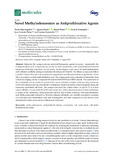Mostrar el registro sencillo del ítem
Novel methylselenoesters as antiproliferative agents
| dc.creator | Díaz Argelich, Nuria | es_ES |
| dc.creator | Encío Martínez, Ignacio | es_ES |
| dc.creator | Plano, Daniel | es_ES |
| dc.creator | Fernandes, Aristi P. | es_ES |
| dc.creator | Palop, Juan Antonio | es_ES |
| dc.creator | Sanmartín, Carmen | es_ES |
| dc.date.accessioned | 2017-11-15T08:00:45Z | |
| dc.date.available | 2017-11-15T08:00:45Z | |
| dc.date.issued | 2017 | |
| dc.identifier.issn | 1420-3049 (Print) | |
| dc.identifier.issn | 1420-3049 (Electronic) | |
| dc.identifier.uri | https://hdl.handle.net/2454/26153 | |
| dc.description.abstract | Selenium (Se) compounds are potential therapeutic agents in cancer. Importantly, the biological effects of Se compounds are exerted by their metabolites, with methylselenol (CH3SeH) being one of the key executors. In this study, we developed a new series of methylselenoesters with different scaffolds aiming to modulate the release of CH3SeH. The fifteen compounds follow Lipinski’s Rule of Five and with exception of compounds 1 and 14, present better drug-likeness values than the positive control methylseleninic acid. The compounds were evaluated to determine their radical scavenging activity. Compound 11 reduced both DPPH and ABTS radicals. The cytotoxicity of the compounds was evaluated in a panel of five cancer cell lines (prostate, colon and lung carcinoma, mammary adenocarcinoma and chronic myelogenous leukemia) and two non-malignant (lung and mammary epithelial) cell lines. Ten compounds had GI50 values below 10 μM at 72 h in four cancer cell lines. Compounds 5 and 15 were chosen for further characterization of their mechanism of action in the mammary adenocarcinoma cell line due to their similarity with methylseleninic acid. Both compounds induced G2/M arrest whereas cell death was partially executed by caspases. The reduction and metabolism were also investigated, and both compounds were shown to be substrates for redox active enzyme thioredoxin reductase. | en |
| dc.description.sponsorship | The authors express their gratitude to the Plan de Investigación de la Universidad de Navarra, PIUNA (Ref 2014-26), “la Caixa” and “CAN” Foundations for financial support for the project. The research leading to these results has also received funding from “la Caixa” Banking Foundation and from the Asociación de Amigos de la Universidad de Navarra, to whom Nuria Díaz-Argelich wishes to expresses her gratitude. | en |
| dc.format.extent | 23 p. | |
| dc.format.mimetype | application/pdf | en |
| dc.language.iso | eng | en |
| dc.publisher | MDPI | en |
| dc.relation.ispartof | Molecules, 2017, 22(8), 1288 | en |
| dc.rights | © 2017 by the authors; licensee MDPI, Basel, Switzerland. This article is an open access article distributed under the terms and conditions of the Creative Commons Attribution (CC BY) license. | en |
| dc.rights.uri | http://creativecommons.org/licenses/by/4.0/ | |
| dc.subject | Methylselenoester | en |
| dc.subject | Methylselenol release | en |
| dc.subject | Cytotoxicity | en |
| dc.subject | Cell cycle arrest | en |
| dc.subject | Cell death | en |
| dc.subject | Thioredoxin reductase | en |
| dc.title | Novel methylselenoesters as antiproliferative agents | en |
| dc.type | Artículo / Artikulua | es |
| dc.type | info:eu-repo/semantics/article | en |
| dc.contributor.department | Ciencias de la Salud | es_ES |
| dc.contributor.department | Osasun Zientziak | eu |
| dc.rights.accessRights | Acceso abierto / Sarbide irekia | es |
| dc.rights.accessRights | info:eu-repo/semantics/openAccess | en |
| dc.identifier.doi | 10.3390/molecules22081288 | |
| dc.relation.publisherversion | https://dx.doi.org/10.3390/molecules22081288 | |
| dc.type.version | Versión publicada / Argitaratu den bertsioa | es |
| dc.type.version | info:eu-repo/semantics/publishedVersion | en |



